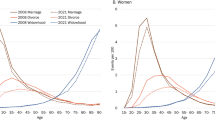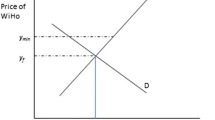Abstract
Characteristics of couples on or about their wedding day and characteristics of weddings have been shown to predict marital outcomes. Little is known, however, about how the dates of the weddings correlate with marriage durability. Using Dutch marriage and divorce registries from 1999 to 2013, this study compares the durations of marriages that began on unusually popular wedding dates with marriages on ordinary dates. We identify several distinct types of popular dates, including Valentine’s Day and numerically special days (dates with the same or sequential number values, e.g., 9.9.99, 1.2.03), showing that on an adjusted basis, the incidence of weddings on such dates was 137–509% higher than ordinary dates. The hazard odds of divorce for these special-date weddings were 18–36% higher than ordinary-date weddings. Sorting on couples’ observable characteristics accounts for some of the higher divorce risks, but even after controlling for these characteristics, special-date weddings were more vulnerable, with 10–17% higher divorce odds compared to ordinary dates. These relationships are even stronger for couples who have not married before.



Similar content being viewed by others
Notes
The administrative records of educational attainment come from municipal authorities. All municipalities provide records for people born on or after 1987, but municipal participation is incomplete for earlier cohorts, with the number of participating areas falling for successively earlier cohorts. The administrative records have been supplemented with national survey data for a small portion of the population. Overall, we observe educational attainment for 58% of women and 51% of men. The availability of education information does not appear to be associated with other personal characteristics except for birth cohort and region.
Metals and engineering, which employed 7.3% of the grooms is the reference category for them; health care, which employed 19.9% of the brides, is the reference category for them.
The baseline categories for men and women are chosen to be the employment sectors with the largest share of workforce of the respective gender.
Limburg is the omitted province in Table 4.
References
Almond D, Chee CP, Sviatschi MM, Nan Z (2015) Auspicious birth dates among Chinese in California. Econ Hum Biol 18:153–159. https://doi.org/10.1016/j.ehb.2015.05.005
Amato PR (2010) Research on divorce: continuing trends and new developments. J Marriage Fam 72(3):650–666. https://doi.org/10.1111/j.1741-3737.2010.00723.x
Associated Press (2009) “Nine times the bliss: 9/9/09 big lucky day for weddings.” nydailynews.com September 9. Accessed May 29, 2016. http://www.nydailynews.com/news/national/times-bliss-9-9-09-big-lucky-day-las-vegas-weddings-article-1.164851
Brien MJ, Lillard LA, Stern S (2006) Cohabitation, marriage, and divorce in a model of match quality. Int Econ Rev 47(2):451–494. https://doi.org/10.1111/j.1468-2354.2006.00385.x
Buckles K, Hungerman D (2013) Season of birth and later outcomes: old questions, new answers. Rev Econ Stat 95(3):711–724. https://doi.org/10.1162/REST_a_00314
Cherlin A (2004) The deinstituionalization of American marriage. J Marriage Fam 66(4):848–861. https://doi.org/10.1111/j.0022-2445.2004.00058.x
de Graf PM, Kalmijn M (2006a) Divorce motives in a period of rising divorce. J Fam Issues 27(4):483–505. https://doi.org/10.1177/0192513X05283982
de Graf PM, Kalmijn M (2006b) Change and stability in the social determinants of divorce: a comparison of marriage cohorts in the Netherlands. Eur Sociol Rev 22(5):561–572. https://doi.org/10.1093/esr/jcl010
Dyer TFT (1881) Domestic folk-lore. London: Cassell, Petter, Galpin
Farmer A, Horowitz A (2015) Strategic non-marital cohabitation: theory and empirical implications. J Popul Econ 28(1):219–237. https://doi.org/10.1007/s00148-014-0517-9
Francis-Tan A, Mialon HM (2015) ‘A diamond is Forever’ and other fairy tales: the relationship between wedding expenses and marriage duration. Econ Inq 53(4):1919–1930. https://doi.org/10.1111/ecin.12206
Goodman J, Irwin J (2006) Special random numbers: beyond the illusion of control. Org Behav Hum Decis Process 99(2):161–174. https://doi.org/10.1016/j.obhdp.2005.08.004
Kalmijn M (2004) Marriage rituals as reinforcers of role transitions: an analysis of weddings in The Netherlands. J Marriage Fam 66(3):582–594. https://doi.org/10.1111/j.0022-2445.2004.00039.x
Kalmijn M, Poortman A-R (2006) His or her divorce? The gendered nature of divorce and its determinants. Eur Sociol Rev 22(2):201–214
Levy B, Chung PH, Slade MD (2011) Influence of Valentine’s day and Halloween on birth timing. Soc Sci Med 73(8):1246–1248. https://doi.org/10.1016/j.socscimed.2011.07.008
Mascarenhas, Rohan (2010) “Thousands of marrying couples make 10/10/10 a date to remember.” nj.com October 10. Accessed May 29, 2016. http://www.nj.com/news/index.ssf/2010/10/thousands_of_weddings_make_101.html
Morgan, Hillary J., and Phillip R. Shaver (1999) “Attachment processes and commmitment to romantic relationships.” In Handbook of interpersonal commitment and relationship stability, edited by Jeffrey M. Adams and Warren H. Jones, 109–24. New York: Springer Science+Business Media, LLC, DOI: https://doi.org/10.1007/978-1-4615-4773-0_6
Murstein, Bernard (1999) “The relationship of exchange and commitment.” In Handbook of interpersonal commitment and relationship stability, edited by Jeffrey M. Adams and Warren H. Jones, 205–20. New York: Springer Science+Business Media, LLC, DOI: 10.1007/978-1-4615-4773-0_12
Ogolsky B, Surra C, Kale MJ (2016) Pathways to commitment to wed: the development and dissolution of romantic relationships. J Marriage Fam 78(2):293–310. https://doi.org/10.1111/jomf.12260
Ohlsson-Wijk S (2014) Digit preferences in marriage formation in Sweden: millennium marriages and birthday peaks. Demogr Res 30(25):739–752. https://doi.org/10.4054/DemRes.2014.30.25
Rao Sahib P, Gu X (2002) ‘Living in Sin’ and marriage: a matching model. J Popul Econ 15(2):261–282. https://doi.org/10.1007/s001480100073
Rao Sahib P, Gu X (2013) As good as married? A model of premarital cohabitation and learning. J Math Sociol 37(3):133–158. https://doi.org/10.1080/0022250X.2011.597013
Rhoades GK, Stanley SM (2014) Before ‘I Do’: what do premarital experiences have to do with marital quality among Today’s young adults? University of Virginia, Charlottesville, The National Marriage Project Accessed May 15, 2016. http://before-i-do.org/
Rusbult C (1980) Commitment and satisfaction in romantic associations: a test of the investment model. J Exp Soc Psychol 16:178–186
Sobotka T, Adigüzel F (2002) Religiosity and spatial demographic differences in the Netherlands. University of Groningen, Groningen
Stanley SM, Rhoades GK, Markman HJ (2006) Sliding versus deciding: inertia and the premarital cohabitation effect. Fam Relat 55(4):499–509. https://doi.org/10.1111/j.1741-3729.2006.00418.x
Surra CA, Hughes DK (1997) Commitment processes in accounts of the development of premarital relationships. J Marriage Fam 59(1):5–21. https://doi.org/10.2307/353658
Surra CA, Arizzi P, Asmussen LA (1988) The association between reasons for commitment and the development and outcome of marital relationships. J Soc Pers Relat 5(1):47–63. https://doi.org/10.1177/0265407588051003
Ting, Inga (2015) “The science behind the weird pattern in Australia’s most popular wedding dates.” Sydney Sun Herald, December 6, first ed.: 7. http://www.smh.com.au/national/what-are-the-most-popular-wedding-dates-in-australia-20151204-glfrod
Treas J, Lui J, Gubernskaya Z (2014) Attitudes on marriage and new relationships: cross-national evidence on the deinstitutionalization of marriage. Demogr Res 30(54):1495–1526. https://doi.org/10.4054/DemRes.2014.30.54
van Loon P, Rogier M v d A, van Dolder D, Wang T (2016) Number preferences in lotteries. Judgm Decis Mak 11(3):243–259
Walker, Peter (2011) “Global wedding rush marks 11-11-11.” theguardian.com November 11. Accessed May 29, 2016. http://www.theguardian.com/news/blog/2011/nov/11/11-11-11-11-11-date-events
Acknowledgements
This research was supported by the Australian Research Council Centre of Excellence for Children and Families over the Life Course. The authors thank Andrew Cherlin, Robert Haveman, Jongsay Yong, colleagues at the Melbourne Institute of Applied Economic and Social Research, workshop participants at the University of North Carolina at Greensboro, and two anonymous reviewers for helpful comments. However, the authors’ findings and views are their own and should not be attributed to the Melbourne Institute.
Funding
Both authors were supported by the Australian Research Council Centre of Excellence for Children and Families over the Life Course.
Author information
Authors and Affiliations
Corresponding author
Ethics declarations
Conflict of interest
The authors declare that they have no conflicts of interest.
Additional information
Responsible editor: Junsen Zhang
Rights and permissions
About this article
Cite this article
Kabátek, J., Ribar, D.C. Not your lucky day: romantically and numerically special wedding date divorce risks. J Popul Econ 31, 1067–1095 (2018). https://doi.org/10.1007/s00148-017-0684-6
Received:
Accepted:
Published:
Issue Date:
DOI: https://doi.org/10.1007/s00148-017-0684-6




